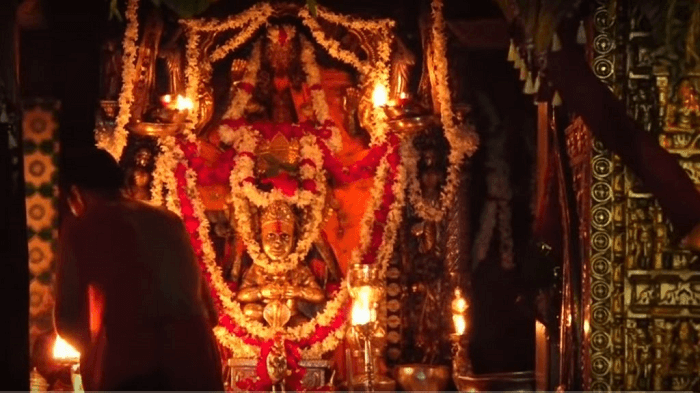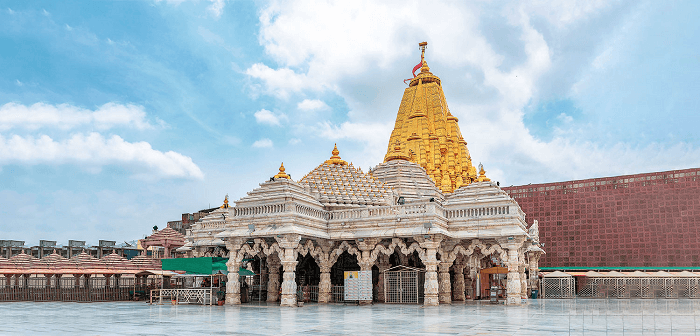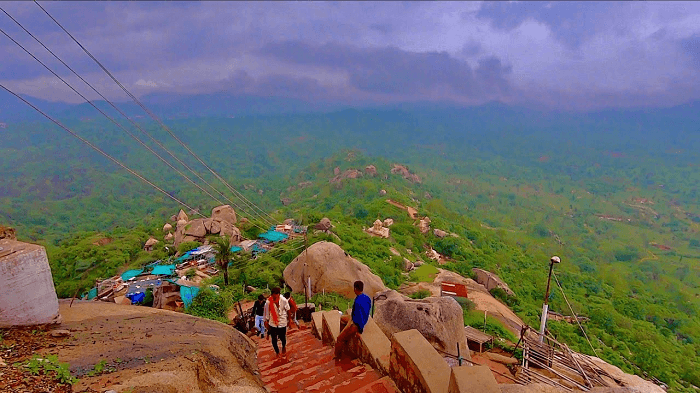Ambaji TempleMillions of worshipers travel to Ambaji each year, making it a significant temple town. It is one of the 51 Shakti Peethas. A significant Shakti Peeth in India also is the Ambaji Mata Temple. This holy temple, which lies close to the Rajasthan border, is one of the most important Shakti Peeth destinations for devoted Hindus. The Ambaji Temple is one of India's oldest and most revered temples. Since the pre-Vedic era, the location has been considered significant, and it now exhibits amazing marble-cut architecture and silver-plated interiors. The majestic Amba Mata deity resides atop the well-known Gabbar hills and is the place's ruling deity. 
There is no statue or representation of the Goddess in the sacred temple of "Arasuri Ambaji"; instead, the revered "Shree Visa Yantra" is the object of worship. The Yantra is invisible to the human eye. It is not permitted to take pictures of the Yantra. The kuldevi of Barad Parmar is known as Arasuri Ambe Mata or Arbuda Mataji. The capital of the entire Parmar clan, Danta, which is situated close by, serves as the location of the one Parmar state. On the town's Gabbar hilltop, Ambaji Mata's original residence is located. People travel here on foot from their homes yearly in September to worship Goddess. The temple receives a lot of yearly visitors, especially around Purnima days. A sizable Mela is held on the full moon day, Bhadarvi Poornima. As the country celebrates the festival of Diwali, the entire town of Ambaji is illuminated. The temple is open from 6 a.m. to 11 p.m., 12 p.m. to 4 p.m., and 6 p.m. to 9 p.m. As a Shakti PeethThe Hindu group Shakta Shaktism holds Shri Amba's shrine in high respect. It is thought that this is where Sati Devi's Heart fell. The story surrounding Daksha Yaga and Sati's self-immolation is where the Shakti Peetha status temple started. When Lord Shiva carried Sati Devi's body in grief after her death, it was thought that the body pieces of her corpse dropped into various areas, resulting in the formation of Shakti Peethas. The Shaivist (Shaivism) branch of Hinduism holds the shrines in the highest regard. Tantra practitioners are the main worshippers of the Shakti Peethas. Architecture
Recent architectural studies have revealed that the Ambaji Temple was built in the 14th century by Vallabhi King Arun Sen. He belonged to the Suryavanshi family. One of the 51 Shakti piths is the Ambaji temple, which is extremely important both architecturally and spiritually. The temple's architecture is highly artistic and lovely and serves as an excellent illustration of Indian tradition and culture. The main Ambaji temple is a tiny structure with a large Mandap and the sacred Gokh of Mata Amba in the Garbh. A beautiful Kalash is mounted at the temple's summit at a magnificent height of 103 feet. The Kalash weighs more than three tonnes and is built from a unique variety of milky white marble hand-selected from the depths of Arasur mines. The Ambaji Mata sacred flag and the magnificent Trishul are displayed on the marble, completely covered in pure Swarna (gold). In front of the old temple, construction has begun on the main temple or Nij Mandir. For the Shakti community devotees, this temple is of utmost importance. Nij Mandir is well-known for being the home of the almighty superpower that guards the universe and its exquisite architecture and elaborate religious carvings. The temple has a total size of 20 meters by 950 meters, excluding the two buildings known as the ancient Havan Shala and the new Havan Shala. The Nij Mandir is a fairly sized structure without a statue or image of the Goddess inside. Sri Asuri Mata Ambaji is thought to reside in a little Gokh within the inner sanctum's walls. The gold-plated Sacred Shakti Yantra, which features mystical writing in 51 Bij letters, is thought to contain her power. The Yantra is not in a clear enough view to be photographed because of its position. The Yantra's overwhelming power is not intended for the eyes of common mortals, which is why it is placed in this location. The temple trust that oversees the Arasuri Mata Ambaji has existed for the past 100 years. The temple's structures are covered in creative decorations, including the Nij Mandir Garbha Griha, Dwar Shakti, Courtyard Shakti, and other sections. For the pleasure of visitors and pilgrims, the Trust has organized an amazing lighting and illumination music performance. The little temple's red flag wavers amiably in the wind. There is only the small side door and the front main entry since it is thought that Mataji has barred the addition of any other doors. A public square known as Chachar Chowk surrounds the temple, and there, ritual sacrifices known as Havans are made. Near the Ambaji Temple, a sacred pond named Mansarovar is rectangular. Religious HistoryInstead of placing an idol or portrait in the inner wall of the temple, a ritual installation of a gold-plated Holy Shakti Visa Shree Yantra with a kurma-back convex design with 51 Bij letters therein, connected to the ancient Yantras of Nepal and Ujjain Shakti Piths, is performed. The worship of this Visa Shree Yantra is only performed after the eyes have been bandaged. It has never been photographed before and cannot be done in the future. Facts About Ambaji TempleEvery day, the Shringar of Mata Ambaji at the Nij Mandir is changed to reflect the different Darshan hours. For example, during the morning hours, it is of a Kumarika Devi; at midday, it is of a young woman; and at night, it is of an older woman. The silver sandals of Mata Ambaji, known as the paduka, are also revered in the main shrine. In addition, there is a large statue of a Holy Lion in front of Gorkha of Mata Ambaji. The devotees used to worship this Holy Lion using the Kanku Puja ritual, another traditional representation of Indian married women who used to wear Kanku on the front of the middle of their heads and hair for the benefit of a happy marital life. There is also an Akhand Divo, or Holy Lamp, at Chachar Chowk that has supposedly been blazing since the time of Akheraj, a trader and Mata Ambaji follower, for a long time. The devotees utilize the same Holy Lamp, which is still burning in front of Mata Ambaji, to put Ghee inside and keep it lit. There is a large Mandap, a Holy Gokh of Mataji in the Garbh-Griha, and a large Chachar Chowk in front of the short and diminutive main Temple of Ambaji. In this Chachar Chowk, Ambaji rites are frequently carried out, and throughout Navratri, worshippers play and relish Mata Ambaji's Garba right in front of the main shrine. Consequently, Mata Ambaji is also known as Chachar Chowkwali. Facts About Gabbar Hills
According to a tale from the Ramayana, when Lord Rama and Laxman visited Shrungi Rushi's Ashram in pursuit of Sitaji, they were instructed to worship Devi Ambaji at Gabbar Hills. When Rama did, Jagat Mata Shakti Devi Ambaji handed him a special arrow called "Ajay," which he used to defeat and kill his adversary Ravana in battle. Maha Rana Pratap, a well-known Mewari Rajput king, was a devoted follower of Arasuri Amba Bhawani. He pledged and presented his renowned sword to Mata Arasuri Ambaji's holy feet because Mata Ambaji once saved him. At the bottom of the hill are 300 stone stairs, following which the journey must ascend a tight, difficult path. The Shri Arasuri Ambaji Mata Devsthan Trust has created a parikrama route around Gabbar hill. This parikrama marg is the site of the 51 Shaktipeeth temples. By performing a Parikrama of Gabbar hill, one can see all 51 Shakti Peeth. The temples are constructed exactly as they were at their original sites. The Trust has installed and inaugurated Udan Khatola facilities, that is, a ropeway on the Gabbar Hills with the assistance of Usha Breco Co. of Calcutta on a lease basis, to develop Gabbar Hills as a hill picnic destination of Gujarat. This was done so that many pilgrims could visit and enjoy the splendor and holiness of Gabbar with comfort and excitement. There are 2 stations: one is a top station with 2 cables, and the other is a base station. It can accommodate 4 people and takes 3-4 minutes to complete. Additionally, this costs 94 Rupees. The ropeway operates from 7:00 a.m. to 7:00 p.m. Important Festivals
AccommodationIn front of Ambica Vishram Gruh and State Transport Bus Stand Depot, Shri. Arasuri Ambaji Mata Devasthan Trust has established a new multi-story building called Shri. Jagat Janani Pathikashram provides affordable yet with some higher and more convenient accommodation and boarding amenities to all classes of pilgrims and worshipers of Mata Amba Bhawani.
Rules for VisitorsVisitors to the Ambaji temple must be properly attired. The followers must know the importance of respecting the mother, especially by dressing appropriately. People over 12 who wear half-pants, shorts, and skirts are prohibited. 'Maa Amba is the Goddess of love and devotion, according to Chandrika Makwana, the chairperson of the Ambika Niketan Temple Trust. How to Reach?
Best Time to VisitBeing a coastal town, Gujarat experiences sweltering summers that are unbearably hot, humid, and burning. The months of October through March are the finest for visiting this temple because temperatures drop significantly and are at their most pleasant for outings for sightseeing. Travel should also be avoided during the monsoon season due to unpredicted fluctuations in the weather.
Next Topic#
|
 For Videos Join Our Youtube Channel: Join Now
For Videos Join Our Youtube Channel: Join Now
Feedback
- Send your Feedback to [email protected]
Help Others, Please Share










